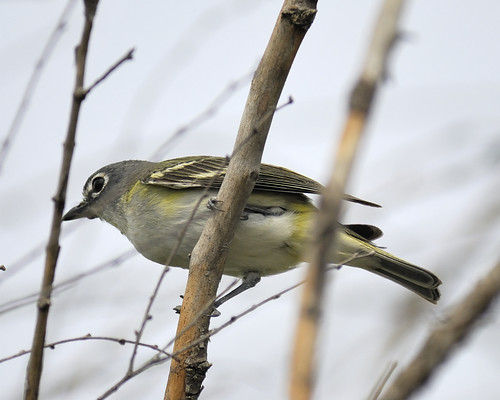tags: Blue-headed Vireo, Vireo solitarius, birds, mystery bird, bird ID quiz
[Mystery bird] photographed at Quintana Neotropical Bird Sanctuary, Brazoria County, Texas. [I will identify this bird for you in 48 hours]
Image: Joseph Kennedy, 27 April 2010 [larger view].
Nikon D200, Kowa 883 telescope with TSN-PZ camera eyepiece 1/1000s f/8.0 at 1000.0mm iso400.
Please name at least one field mark that supports your identification.
The Blue-headed Vireo is a common and vocal bird of northeastern forests. Formerly lumped as a "Solitary Vireo" with the more western Plumbeous and Cassin's vireos, it is now considered a separate species. The Blue-headed Vireo is the earliest vireo species to show up in the spring.
More like this
tags: Bell's Vireo, Vireo bellii, birds
tags: Blue Mountain Vireo, Vireo osburni,
tags: Hutton's Vireo, Vireo huttoni, b
tags: birds, birding, word play,


Ok, so it's either a Cassin's Vireo (Vireo cassinii) or Blue-headed Vireo (Vireo solitarius). Although I wouldn't say that I could identify this bird from this image, I am leaning towards Cassin's Vireo and here's why:
1. The throat doesn't appear to contrast with the gray on the head. Blue-headed Vireo shows quite the contrasting, snow-white throat. The throat of this individual is more of a slushy gray.
2. The lores appear to be darker than the gray color of the head whereas the lores of Blue-headed Vireo are the same color as the gray on the head. Don Roberson makes a fair argument for this field mark at http://creagrus.home.montereybay.com/sovi-id-comm.html
I'm not sure which it is though, because I can't see the top of the head very well (for a better assessment of head color) nor can I discount the possibility that the white throat looks darker because of poor lighting.
Totally unrelated, but emus are assholes.
There's this one emu at the zoo that can't stop running after my camera.
I agree with most of Pat's comments, especially that last one about the lighting.
As I don't have an up-to-date N.American guide can someone tell me if the wingbar colour is a diagnostic feature to separate Blue-headed and Cassin's. NatGeo suggests it is and also there is a difference in range, which has probably changed since it was published?
in addition to range, i believe that the time of arrival in spring is also an indication as to which species you are looking at.
Just checked the larger image and I think that the throat contrast mentioned by Pat (a very useful mark) is obscured by a very poorly placed twig. Obviously, by range this is most likely to be a Blue-headed, and if NatGeo is right (thanks, Adrian, I hadn't bothered) then the yellow tinge to the wing bars and the strength of the white edging on the tail feathers suggest Blue-headed. (Adrian, I'm working with the 5th edition, spring 2006 -- I haven't got anything more recent either.)
I wasn't aware of a difference in migration timing, probably because I've never been in a place where Blue-headed and Cassin's are both likely.
And just for the record, this bird is definitely part of the old Vireo solitarius complex.
Thanks Paul, Your edition is younger than my 3rd, so I think I'll go with yours. Thanks to Grrl for the clue about arrival times, so I think this is more likely to be Blue-headed Vireo. I really will have to invest in Sibley, though.